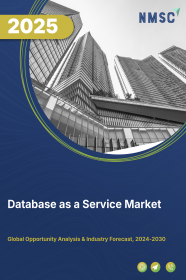
Database as a Service Market by Type (SQL and NoSQL), by Component (Solution and Services), by Service (Public Cloud Service, Private Service, and Software), by Deployment (On-Premise and Cloud Based), by Organization Size (Small and Medium Enterprises, and Large Enterprises) - Global Opportunity Analysis and Industry Forecast 2022-2030
US Tariff Impact on Database as a Service Market
Trump Tariffs Are Reshaping Global Business
Market Definition:
The Database as a Service Market size was valued at USD 17.48 billion in 2021 and is predicted to reach USD 80.95 billion by 2030 with a CAGR of 19.3% from 2022-2030.
Database as a service (DBaaS) refers to a cloud-based software tool that ensures the accessibility of complex data conveniently and cost-effectively for businesses. DBaaS is used while managing and analyzing data with business intelligence in the data warehouse. DBaaS is enabled by software as a service (SaaS) technology that permits its users to manage, provision, configure, consume, and operate database software using common set of abstractions. This software led to the improvement and standardization of performance, productivity, and data security of databases.
Additionally, DBaaS provides features such as database replication across multiple geographical locations and backup & recovery options that reduce security concerns. The provider of this service manages everything from periodic upgrades to backups to ensure the smooth workflow of the database system.
Market Dynamics and Trends:
Increasing demand for large storage space and growing need for self-driving cloud databases from various end users such as BFSI and telecommunication have been driving the growth of DBaaS market. Also, rapid digitalization paired with increased data volumes generated by healthcare & life sciences industry is driving the growth of the market. Moreover, rising penetration of high-speed internet network infrastructure, which enables users to access data irrespective of its location is expected to further propel the growth of the market.
Furthermore, integration of DBaaS into software as a service (SaaS) reduces operational costs and improves workflow process by proving better monitoring, upgrades and patches, disaster recovery, and security boosting the market growth.
However, growing cyber-attacks that led to privacy and security concerns are the factors that restrain the growth of the market. On the contrary, DBaaS offers test on-site and cloud-based tools to avoid the upfront capital costs of IT infrastructure for enterprises, which is expected to create ample growth opportunities for the market in the coming years.
Market Segmentations and Scope of the Study:
The database as a service market is segmented on the basis of type, component, service, deployment, organization size, industry vertical, distribution model, and geography. On the basis of type, the market is divided into SQL and NoSQL. On the basis of component, the market is classified into solution and services. On the basis of service, the market is categorized into public cloud service, private service, and software. On the basis of deployment, the market is bifurcated into on-premise and cloud based. On the basis of organization size, the market is segmented into small and medium enterprises, and large enterprises. On the basis of industry vertical, the market is divided into BFSI, telecommunication & IT, retail & e-commerce, healthcare & life sciences, manufacturing, government, energy & utilities, media & entertainment, professional services, academic, defense, travel & hospitality, and others. On the basis of distribution model, the market is classified into hybrid cloud, public cloud, and private cloud. The geography breakdown and analysis of each of the aforesaid segments include regions such as North America, Europe, Asia-Pacific, and RoW.
Geographical Analysis:
North America region is expected to hold the lion share of database as a service market size and is expected to continue dominating the market during the forecast period. This is attributed to factors such as dominance of U.S. and Canada in DBaaS market due to the wide application of DBaaS for industrial use with advanced database technology including Microsoft SQL Server, MongoDB, and Elasticsearch. Also, the growing innovation in database as a service by the regional players such as Microsoft, AWS, and Oracle Corporation boosts the market growth in this region.
For instance, in November 2021, Microsoft announced the private preview of its flagship database product, SQL Server 2022. This will offer customers the advantage of powerful new capabilities prior to the general availability (GA) of the on premise product. It also delivers Microsoft the advantage of very carefully monitoring the user experience and performance.
On the other hand, Asia-Pacific has also witnessed the penetration of DBaaS due to the flexibility and efficiency of DBaaS in small and medium enterprises (SMEs) due to low operational costs.
For instance, according to SME Finance Forum, SMEs comprise more than 98% of the number of enterprises in Asia-Pacific region. These contribute from about 17% to national GDP in low-income countries including India to about 40 to 50% in higher income countries like Malaysia and Singapore. In addition, rapid integration of NoSQL in organizations for large amounts of data that includes real-time personalization and user profile management, which is designed to handle huge data with high availability and low latency at a global scale and with no single point of failure. These factors boost the market growth in this region.
Competitive Landscape:
The database as a service market includes various market players such as ScyllaDB, Hitachi Vantara, AWS, Microsoft Corporation, Oracle Corporation, SAP SE, IBM Corporation, Google LLC, CenturyLink Cloud and Rackspace US, Inc. These market players are adopting various joint venture strategies and planning expansion of business across various regions to maintain their dominance in the DBaaS.
For instance, in August 2021, ScyllaDB announced that NoSQL database is available and companies can able to load their data by using ScyllaDB Cloud on Google Cloud. It delivers high performance with low latency, minimizes data infrastructure costs, and helps with administrative overhead. In March 2020, Hitachi Vantara entered in strategic partnership with Informatica and Hitachi Vantara, for the integration of databases to modern NoSQL data platforms like MongoDB to help various organizations. Hitachi Vantara is working with MongoDB for availability of a modernization solution that will allow customers to better move data from traditional data platforms like Oracle to MongoDB.
Key Benefits:
-
The database as a service market report provides the quantitative analysis of the current market and estimations from 2022 to 2030. This analysis assists in identifying the prevailing market opportunities to capitalize on.
-
The study comprises of an extensive analysis of the database as a service market trend including the current and future trends for depicting the prevalent investment pockets in the market.
-
The information related to key drivers, restraints, and opportunities, and their impact on the database as a service market is provided in the report.
-
The competitive analysis of the market players along with their market share in the database as a service market is mentioned.
-
The SWOT analysis and Porter’s Five Forces model are elaborated in the study.
-
The value chain analysis in the market study provides a clear picture of the stakeholders’ roles.
Key Market Segments:
By Type
-
SQL
-
NoSQL
By Component
-
Solution
-
Services
By Application
-
Public Cloud Service
-
Private Service
-
Software
By Deployment
-
On-Premise
-
Cloud Based
By Organization Size
-
Small And Medium Enterprises
-
Large Enterprises
By Industry Vertical
-
BFSI
-
Telecommunication & IT
-
Retail & E-commerce
-
Healthcare & Life Sciences
-
Manufacturing
-
Government
-
Energy & Utilities
-
Media & Entertainment
-
Professional Services
-
Academic, Defense
-
Travel & Hospitality
-
Others
By Distribution Model
-
Hybrid Cloud
-
Public Cloud
-
Private Cloud
By Geography
-
North America
-
The U.S.
-
Canada
-
Mexico
-
-
Europe
-
The U.K.
-
Germany
-
France
-
Italy
-
Spain
-
Rest of Europe
-
-
Asia-Pacific
-
China
-
India
-
Japan
-
South Korea
-
Australia
-
Rest of Asia-Pacific
-
-
RoW
-
UAE
-
Saudi Arabia
-
South Africa
-
Brazil
-
Remaining countries
-
REPORT SCOPE AND SEGMENTATION:
|
Parameters |
Details |
|
Analysis Period |
2021–2030 |
|
Base Year Considered |
2021 |
|
Forecast Period |
2022–2030 |
|
Market Size Estimation |
Billion (USD) |
|
Market Segmentation |
By Type (SQL and NoSQL), by Component (Solution and Services), by Service (Public Cloud Service, Private Service, and Software), by Deployment (On-Premise and Cloud Based), by Organization Size (Small and Medium Enterprises, and Large Enterprises), by Industry Vertical (BFSI, Telecommunication & IT, Retail & E-commerce, Healthcare & Life Sciences, Manufacturing, Government, Energy & Utilities, Media & Entertainment, Professional Services, Academic, Defense, Travel & Hospitality, and Others), and by Distribution Model (Hybrid Cloud, Public Cloud, and Private Cloud) |
|
Geographical Segmentation |
North America (U.S., Canada, Mexico) Europe (UK, Germany, France, Italy, Spain, Rest of Europe), Asia-Pacific (China, India, Japan, South Korea, Australia, Rest of Asia-Pacific), Rest of the World (UAE, Saudi Arabia, South Africa, Brazil, Remaining countries) |
|
Companies Profiled |
ScyllaDB, Hitachi Vantara, AWS, Microsoft Corporation, Oracle Corporation, SAP SE, IBM Corporation, Google LLC, CenturyLink Cloud and Rackspace US, Inc. |
Key Players:
-
ScyllaDB
-
Hitachi Vantara
-
AWS
-
Microsoft Corporation
-
Oracle Corporation
-
SAP SE
-
IBM Corporation
-
Google LLC
-
CenturyLink Cloud
-
Rackspace US, Inc

















 Speak to Our Analyst
Speak to Our Analyst





















